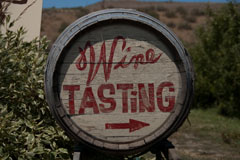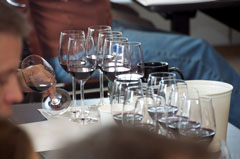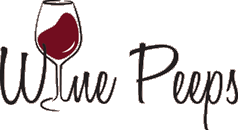How to Taste Wine with Confidence
By Kori ~ October 27th, 2010.
 Wine is a beverage to be enjoyed, preferably in the company of friends. Unfortunately, though, many people find wine intimidating. For many, making it through the onslaught of bottles at the local grocery store or wine shop and actually choosing a bottle is just half the battle. Now, it’s time to drink it. If all you want to do is drink a glass of wine with dinner and not think about it, that is perfectly acceptable. However, if you would like to have an idea of what to look for in a wine to evaluate it and discuss it with others, here is a basic tasting methodology for you to follow or adapt to your own purposes. It is broken down into five steps (the 5 – S’s): See, Sniff, Sip, Spit or Swallow, and Summarize. Be sure to take good notes (mental or written) during each step.
Wine is a beverage to be enjoyed, preferably in the company of friends. Unfortunately, though, many people find wine intimidating. For many, making it through the onslaught of bottles at the local grocery store or wine shop and actually choosing a bottle is just half the battle. Now, it’s time to drink it. If all you want to do is drink a glass of wine with dinner and not think about it, that is perfectly acceptable. However, if you would like to have an idea of what to look for in a wine to evaluate it and discuss it with others, here is a basic tasting methodology for you to follow or adapt to your own purposes. It is broken down into five steps (the 5 – S’s): See, Sniff, Sip, Spit or Swallow, and Summarize. Be sure to take good notes (mental or written) during each step.
First, pour about 1/3 glassful of wine in an appropriate tasting glass.
SEE: Tilt the glass at a 45-degree angle away from you against a white background with good lighting.
- Is the wine brilliant, clear, or hazy?
- Do you see any bubbles or ropiness?
- Is the color pale or intense (appropriate for the varietal)?
- Does it have good color depth or density?
Sight is the first of our senses that we use in wine tasting. What you see gives you a sneak preview, clues as to what to expect.
SNIFF: Swirl the wine gently in the glass to aerate it and release its bouquet, then put your nose inside the rim of the glass and take a couple of slow, deep sniffs to smell for aromas.
- Is the wine clean, or are there any off-odors?
- Are the aromas faint or intense?
- What are the aromas? Does it smell like fruit, flowers, spice, etc?
- Does the wine smell oaky? (American Oak: overt, vanilla, perception of sweetness; French Oak: subtle, spicy, kicks in on the mid-palate)
SIP: Take a small amount of wine into your mouth, let it lie on your tongue a few seconds and then slowly draw in some air through your lips, and then swish the liquid around like mouthwash, bringing it into contact with every part of your mouth.
- Is the wine sweet or dry? (<0.5% residual sugar is considered dry)
- Does the wine fill your mouth, i.e. have body? Does it feel more like water (light-bodied) or cream (full-bodied)?
- What are the flavors and are they intense or diluted? (Do they have the subtlety of an Old World wine or the boldness of a New World wine?)
 Take another sip and evaluate the acidity, tannins, and alcohol.
Take another sip and evaluate the acidity, tannins, and alcohol.
- Is there a tingle around the sides or tip of your tongue? Does it have sourness like lemonade (tart), is it flat like water, or something in between (crisp, zesty)? Wines with high acidity leave your mouth initially feeling dry but that dryness is soon replaced with significant saliva production.
- Is there a puckering dryness (astringency), a rough gritty feeling, or even bitterness on your tongue or inner cheeks, like strong iced tea would cause? Wines with high tannins leave your mouth feeling dry and cottony.
- Does the wine taste hot at the back of your mouth? This can be a sign of high alcohol.
- Are the flavors, acidity, tannins, and alcohol in equilibrium? If yes, then the wine is said to be well-balanced. Too much alcohol and not enough acidity and tannins means a wine is soft. Too much acidity and tannins and not enough alcohol means a wine is harsh. A well-balanced wine will become smooth and integrated as it matures.
- Do you find something new in the wine each time you come back to it? Do you taste a number of different flavors? If yes, then the wine has good complexity.
SPIT or SWALLOW: Spit or swallow the wine and record your impressions. If you are tasting a number of wines (at a tasting event or visiting wineries), I highly encourage you to spit. Otherwise, you end up drinking too much which won’t feel good the next morning and you won’t be able to really tell which wines you like and don’t like after the first few you taste.
SUMMARIZE: After you spit or swallow, you can close your mouth and breathe out through your nose for further evaluation of the wine.
- Is it free of measurable wine faults? Off-odors such as musty, moldy, rotten eggs, and fingernail polish remover can be indicators of wine faults.
- How long after you swallow do the flavors linger? A finish of <5 seconds is short, 5-9 seconds is moderate, 10-15 seconds is long, and 15+ seconds is lingering. The longer the finish, the better.
- What is the wine’s overall quality?
- Do you like the wine personally?
- How would you describe the wine in one sentence? Try to describe what you like or don’t like about the wine rather than just saying “I like it†or “I don’t like itâ€. It doesn’t have to include any fancy wine-speak, just a simple sentence like, “This wine is not well-balanced; I’d prefer a wine with more fruit and less alcohol.â€
- And, finally, keep written tasting records. You’ll find it valuable and entertaining to look back on in the future.
I hope that these basic steps demystify the wine tasting experience and allow you to taste wine with confidence. After all, wine is just a beverage, and you should have fun drinking it and talking about it. Cheers!
Filed under: General Wine Information

 Wine Peeps is an independent wine blog dedicated to helping you get the most bang for your buck in wine. We do this through blind tastings of wine from around the world and calculations of
Wine Peeps is an independent wine blog dedicated to helping you get the most bang for your buck in wine. We do this through blind tastings of wine from around the world and calculations of 











[…] How to Taste Wine with Confidence was originally posted on Wine Peeps on Wed, 27 Oct 2010 14:00 UTC. Wine Peeps – Your link to great QPR wines from Washington State and beyond. […]
[…] How to Taste Wine with Confidence (winepeeps.com) […]
[…] winepeeps.com/2010/10/27/how-to-taste-wine-with-confidence/ Share/Bookmark […]
[…] winepeeps.com/2010/10/27/how-to-taste-wine-with-confidence/ […]